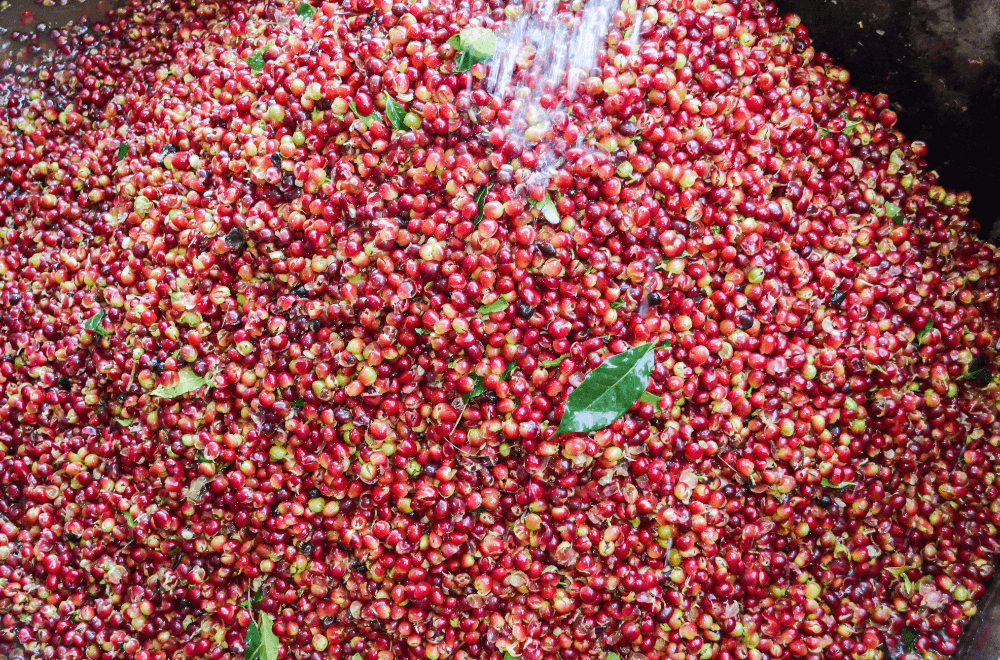Have you ever wondered, “how does Peet’s decaffeinate their coffee?” The brand uses water processing for its decaf blends; let’s learn more about the process.

Defying the negative stigma, the decaf coffee market is expected to grow with a compound annual growth rate of 7% over the forecast period from 2022-2028. So, you might wonder, how does Peet’s decaffeinate their coffee? Peet’s handcrafted decaf coffee has transitioned to water processing across the board, including all of its ground, whole bean, and K-cups.
Water-processing decaf coffee steer clears from the use of chemicals during its process to ensure caffeine is naturally removed and preserve the integrity, taste, and quality of the beans. Such a meticulous decaffeination process allows Peet’s to stay aligned with its premium, ethically, and sustainably selective green beans, exactly how they source beans for their regular coffee.
Not All Decaf Is The Same
There are three main decaf methods: water-processed, chemical solvent-processed, and carbon dioxide process. If you break it down further, the chemical-solvent process includes indirect-solvent and direct-solvent processes using methylene chloride or ethyl acetate.
However, with the rise of health-conscious consumers, non-chemical decaf coffee is believed to be the best. And that’s what makes Peet’s Coffee stand out from the crowd.
The team at Peet’s Coffee strongly believes that decaf coffee should be as enjoyable as regular caffeinated coffees. For that reason, Peet’s has been using water-processed decaf coffee for all decaf products. As a result, Peet’s decaf coffee is widely known for its excellent richness and depth to the point that it tastes exactly like the real thing.
What Makes Peet’s Decaf Coffees Different?
Peet’s is one of a few premium coffee brands adhering to the water-process decaffeination method. Some other popular brands on the same boat include Kicking Horse Coffee and Volcanica.
Peet’s Coffee works directly with its suppliers across continents to get green beans. And it uses the same raw beans to filter down caffeinated and decaffeinated coffee.
While some other brands stock decaf beans from decaffeination companies, Peet’s shuns fillers, blenders, or shortcuts to maintain the excellent quality of each cup. After water processing, they roast the beans by hand with high standards. For that reason, Peet’s decaf coffee is always delicious.
Learn more in our explainer on where did Peet’s Coffee start.
A Glimpse Into Water Process Decaffeination
So, what does water process decaffeination even mean? First, they submerge freshly harvested green coffee beans in warm water and then through an activated carbon filter.

As they extract all the soluble material from the beans, the caffeine content starts to flow out while the flavors stay intact.
For that reason, Peet’s coffee beans can preserve all the flavors but not caffeine. The in-house roasters begin to dry the beans and carefully hand-roast them out of their roastery in Alameda, California. You might be interested in our guide on where to buy Peet’s coffee.
Peet’s Partnership With Swiss Water Process
Peet’s Coffee has been partnering with numerous expert water process decaffeination companies, and Swiss Water Process is one of them. This brand uses its patented decaffeination method to remove 99.9% of Peet’s caffeine content.
You might wonder, how is it even possible that only filtered water can get rid of caffeine in coffee without messing with its original flavor? Swiss Water has developed a proprietary Green Coffee Extract (also known as GCE for short). This extract solution contains all the water-soluble compounds found in coffee but not caffeine.
The caffeinators then heat the solution until the raw coffee beans start to swell and become porous. As long as the beans swell, the caffeine compounds can escape the beans and head into the GCE through osmosis.
Meanwhile, the authentic coffee flavor stays intact because other volatile compounds defining flavor and aroma stay in place. The process keeps going until 99.9% caffeine content is gone.
That 99.9% benchmark is one of the most common standards required worldwide for coffee to be recognized with a sleep-friendly label. Meanwhile, if coffee is marked as 97% decaffeinated, it’s known as fidget-free coffee. Learn more in our decaf coffee guide.
5 Best Peet’s Decaf Coffee Blends
Decaf Major Dickason’s Blend
The best decaf ground from the brand for blend lovers goes to Major Dickason. The decaf version uses 100% Arabica coffee. This dark roast delivers a full-bodied and robust flavor profile.
I like to have this signature blend to make drip or a pour-over coffee and let its richness stimulate my brain in the morning. Other than drip and pour-over, you can also use this Decaf Major Dickason’s Blend for espresso, cold brew, or French press.
Peet’s Coffee Decaf Mocca Java
Peet’s Coffee Decaf Mocca Java is not as well known as the Major Dickason blend, but it’s full of potential. Peet’s is best known for dark coffee, and this is no different.
It brings out the finest terroirs of Ethiopia, the birthplace of coffee, with its Mocca beans coupled with Javanese descendants. When the blend goes through the water-process decaf method, each sip expresses a brilliant and complex dimension. On top of that, you will see a subtle hint of chocolaty sweetness in the aftertaste.
Peet’s Decaf House Blend
If a classic coffee with a smooth, satisfying, and sweet profile is what your heart desires, don’t look over the House Blend.
Once again, its signature dark roast emerges to be a top call, using high-grown, finest-quality coffee to maximize flavor. My favorite way to brew it is with a drip or a pour-over.
Peet’s Decaf French Roast Whole Bean
Whole bean coffee for long-lasting freshness, this Peet’s decaf French roast is just purely fantastic. Not only is each batch perfectly roasted and fragrant with a beautiful gloss, but the flavor is also exploded with its smoothness and boldness.
As fans attested, Peet’s Decaf French Roast Whole Bean is the best choice for those who are shy from yucky decaf coffee. Its smoky overtones and pleasant bite will change their mind.
Peet’s Decaf Ristretto Intensity 9

If there’s one decaf K-cup from Peet’s I love the most, that would be Arabica Intensity 9 blend. This Intensity 9 captures my attention with its round-body blend that’s silky smooth and aromatic. Toasted almond serves as an undertone, promoting the signature boldness of Peet’s famous espresso line.
Each sip is soaked in complexity and nuances with a beautiful crema in the brew. As long as you have a Nespresso original machine at home, you’re guaranteed stable brewing and exact pull every single time. On top of that, you will have a lot more fun recycling its aluminum capsules via Peet’s mail-back program.
Other than those five, its Decaf Big Bang, Decaf Sumatra, Decaf House Blend K-Cups, and Decaf Especial K-Cups are also worth trying. Peet’s also offers limited-edition items such as Holiday Blend and Decaf Bundle if you’re looking for a gift on a special occasion. You might also be wondering whether green coffee beans contain caffeine.
FAQS About Peet’s Coffee
Where Is Peet’s Coffee Grown?
These farmers have been working tirelessly on their family farms for generations. The coffee plantations are grown at high altitudes, receive steady rainfall, and have quality, nutrient-rich soil. By ringing true to this devotion, Peet’s sustainable relationship with those native farmers helped the brand achieve the prestigious LEED Gold Status, becoming the first artisan coffee roastery in the United States to hold the award.
